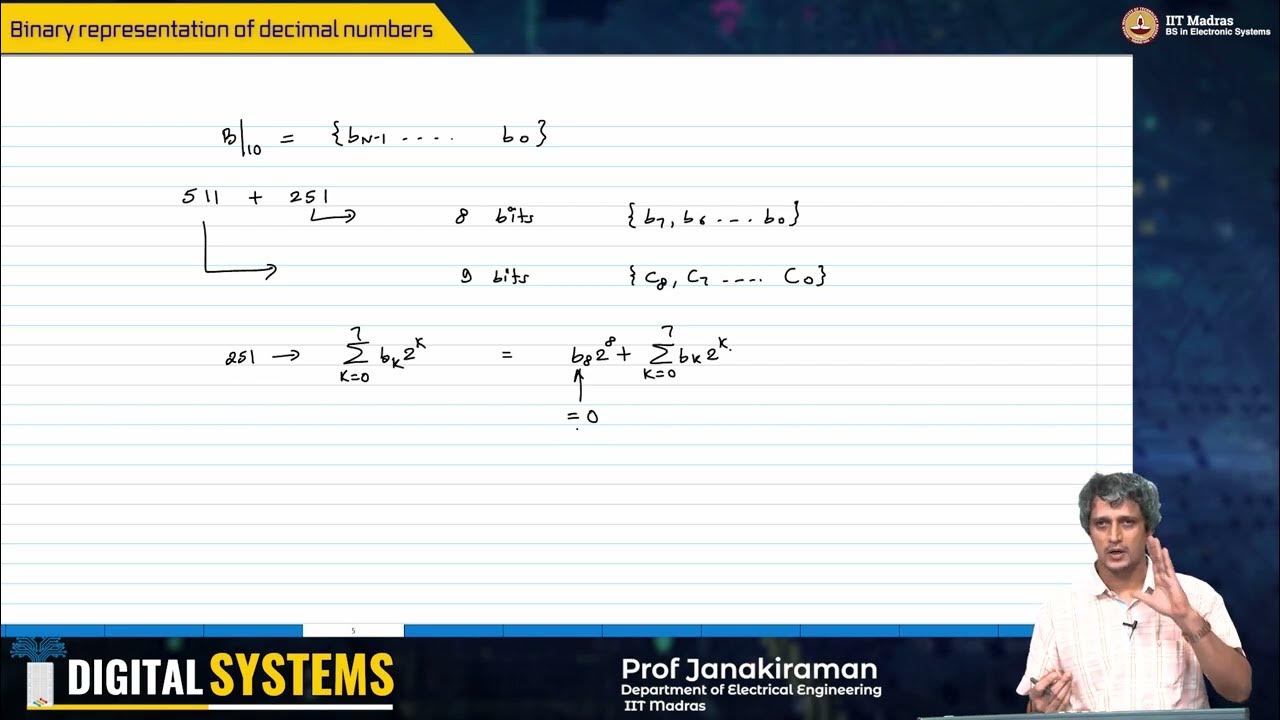78. OCR A Level (H046-H446) SLR13 - 1.4 Converting between binary, hex & denary
Summary
TLDRThis video tutorial offers a comprehensive guide on converting positive integers between binary, hexadecimal, and DNA (decimal) number systems. It demonstrates the process using a table for easy reference and step-by-step examples, including converting DNA numbers like 12, 24, 230, and 100 into hexadecimal. The video also covers converting hexadecimal numbers back to binary and DNA, using nibbles (groups of four bits) to simplify the process. Key takeaways include understanding how to group binary digits into nibbles and the significance of hexadecimal letters in the conversion process.
Takeaways
- 🧬 Converting DNA numbers to hexadecimal involves first expressing the number in binary form.
- 🔢 For smaller numbers like 12, the binary is written out and grouped into 'nibbles' of four bits each to form hexadecimal.
- 🔡 The hexadecimal system uses letters (A-F) to represent values 10-15, which are crucial for larger numbers.
- 📚 The script demonstrates converting numbers like 24 and 230 to hexadecimal, emphasizing the process of grouping and translating binary nibbles.
- 🔑 It's important to note that not all DNA numbers will convert to hexadecimal numbers containing letters.
- 🔄 The process for converting from hexadecimal to binary (and then to DNA) is outlined, highlighting the reverse operation.
- 📈 For larger hexadecimal numbers like 'AB', each hexadecimal digit is converted to its 4-bit binary equivalent.
- 🔎 The script provides a method to add up the binary values to get the original DNA number.
- 📝 Examples are given for converting numbers like 100, 230, and 'AB' in hexadecimal to DNA numbers.
- 🎓 The video aims to educate viewers on how to convert between different base number systems: binary, DNA, and hexadecimal.
Q & A
What are the three base number systems discussed in the video?
-The three base number systems discussed are binary (base 2), hexadecimal (base 16), and DNA (interpreted as base 10).
How do you convert the DNA number 12 to hexadecimal?
-First, convert 12 to binary, which is 1100 (8 + 4 = 12). Then, split the binary into two nibbles (0000 and 1100), and convert each nibble to hex. 0000 is 0, and 1100 is 12, which is C in hex. So, the hex value of 12 is C.
Why is it useful to convert DNA numbers to hexadecimal through binary?
-Converting through binary makes the process more straightforward because binary to hexadecimal conversions involve grouping bits into nibbles (groups of four), which is easier to manage when working with powers of two.
What is a nibble, and how is it used in the conversion process?
-A nibble is a group of four bits. In binary to hex conversion, binary numbers are grouped into nibbles, each of which can be directly converted to a hexadecimal digit.
What is the hexadecimal representation of the DNA number 24?
-First, convert 24 to binary: 11000 (16 + 8 = 24). Group the bits into two nibbles (0001 and 1000). 0001 is 1 in hex, and 1000 is 8 in hex, so 24 in DNA is 18 in hexadecimal.
How do you convert larger numbers like 230 from DNA to hexadecimal?
-Convert 230 to binary: 11100110 (128 + 64 + 32 + 4 + 2 = 230). Group the bits into two nibbles (1110 and 0110). 1110 is E in hex, and 0110 is 6 in hex, so 230 in DNA is E6 in hexadecimal.
What is the importance of remembering hex digits as separate characters rather than decimal numbers?
-In hexadecimal, digits represent values from 0 to 15. For example, 18 in hexadecimal is 1 and 8, not eighteen. Treating them as separate digits ensures correct conversion and avoids confusion with decimal notation.
How do you convert hexadecimal digits back to binary?
-Each hexadecimal digit is converted into a 4-bit binary value. For example, A (hex) represents 10 in decimal, which is 1010 in binary. Similarly, B (hex) represents 11 in decimal, which is 1011 in binary.
What is the binary representation of the hex number 3F?
-The hex digit 3 is 0011 in binary, and the digit F is 1111 in binary. Together, 3F is represented as 00111111 in binary.
How do you convert the hexadecimal digit AB to DNA?
-Convert A (1010) and B (1011) to binary first. Then, sum the binary values: 10101011 in binary equals 128 + 32 + 8 + 2 + 1, which is 171 in DNA.
Outlines

このセクションは有料ユーザー限定です。 アクセスするには、アップグレードをお願いします。
今すぐアップグレードMindmap

このセクションは有料ユーザー限定です。 アクセスするには、アップグレードをお願いします。
今すぐアップグレードKeywords

このセクションは有料ユーザー限定です。 アクセスするには、アップグレードをお願いします。
今すぐアップグレードHighlights

このセクションは有料ユーザー限定です。 アクセスするには、アップグレードをお願いします。
今すぐアップグレードTranscripts

このセクションは有料ユーザー限定です。 アクセスするには、アップグレードをお願いします。
今すぐアップグレード関連動画をさらに表示

77. OCR A Level (H046-H446) SLR13 - 1.4 Hexadecimal representation

Konversi Bilangan Hexadesimal ke Basis Bilangan Yang Lain

Tutorial Lengkap: Konversi Bilangan Biner, Oktal, Desimal, dan Heksadesimal

Teknologi Digital • Part 1: Pengertian Teknologi Digital, Sistem Bilangan, dan Kode Biner

Tutorial Lengkap: Cara Konversi Bilangan Desimal ke Biner, Oktal dan Hexadesimal

W2_L2_Binary representation of decimal numbers
5.0 / 5 (0 votes)
